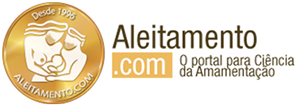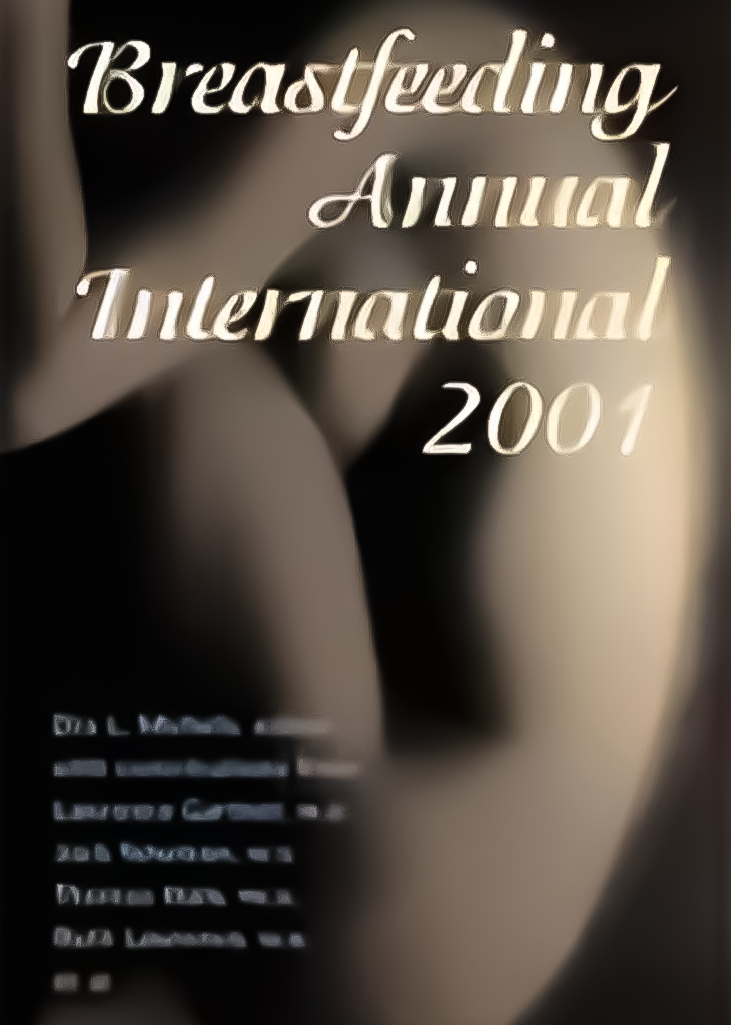Livraria
Tema: Medicina pediátrica
ISBN: 9788527716277
Edição: 3ª
Ano: 2010
Idioma: Português
Formato: Impresso
Editora: Guanabara Koogan
Autor(es):
Marcus Renato de Carvalho
Raquel Nascimento Tamez
Breastfeeding Annual International 2001
Product Description
An anthology of the latest information from leading lactation professionals on such topics as breastfeeding in the workplace or after cancer surgery, breastfeeding for people with AIDS, the option of wet nursing, and whether mothers may drink alcohol while breastfeeding. This anthology is a distillation of the latest information on breastfeeding in a format accessible to both parents and health care professionals.
From the Publisher
What Only a Woman Can Do – Breastfeed
Anyone can change a baby’s diaper, rock a baby to sleep and take a baby for a walk, but just as only a woman can produce a child, so too, only a woman can provide that child with the perfect food: breast milk. Breastfeeding is a perfectly natural act, but like other natural events, such as menopause, it may prove more difficult for some women than others. Nevertheless, it is always worth the effort because of its overwhelming benefits to both mother and baby.
People working with new mothers at all levels of health care should be aware of the importance of breastfeeding to ensure that mothers do not see it as one of two choices but as the best choice and, when possible, the only choice.
THE MEDICAL VIEW
After a period during which only lip service was often given to the saying “breast is best,” the people who know about the subject of breastfeeding from a medical perspective – pediatricians, obstetricians and family doctors – agree that breat milk is best for babies, including premature and sick babies. In the past, doctors only recommended breast milk for full-term babies with no health problems.
Now, since December 1997, the American Academy of Pediatrics in a policy statement written by the Work Group on Breastfeeding, of which I was chairman, recommends breat milk for infants born prematurely, and also those with a variety of illnesses including repiratory and infectious diseases as well as potential hindrances to breastfeeding such as cleft palate and Down syndrome.
These guidelines, which the American Academy of Pediatrics points out reflect “the considerable advances that have occurred in recent years in the scientific knowledge of the benefits of breastfeeding, in the mechanisms underlying these benefits and in the practice of breastfeeing,” urge “Enthusiastic support and incolcement of pediatricians in the promotions and practice of breastfeeding” and that babies, including premature ones, should be exclusively breastfed for 6 months, then breastfed in combination with solid food for at least another 6 months – one full year or longer.
As pediatricians, we recommend this because breast milk not only provides an infant with the calories and fluid it needs for growth and development, but also provides significant protection against chronic diseases such as asthma and lymphoma, and infectious diseases including diarrhea, ear infections, meningitis, and pneumonia. The immune components of breast milk constantly change to meet the infant’s needs to be protected against new infections.
Breast milk is what the newborn needs – and in nearly all cases it is all that the newborn needs for about the first six months of life. Therefore, it is vitally important for mothers to begin breastfeeding in the hospital or pumping to provide breast milk even if the infant cannot breastfeed directly.
OFF TO A GOOD START
Those doctors and other caregivers who have worked for years with breastfeeding mothers and their new babies know the major importance of getting breastfeeding off to a good start. The AAP recommends that breastfeeding begin within the first hour of birth. The AAP guidelines emphasize that no water, glucose water or infant formula should be given to a breastfeeding newborn unless there are specific medical indications. Mothers should provide expressed breast milk for times when they are separated from their new babies because of infant or maternal illness. In order to assist mothers who must express milk, hospitals should provide quality breast pumps to such mothers.
Once a mother goes home, she is in a world that uses the baby bottle as the universal symbol of infant feeding. Mothers, most of whom are not trained in the physiology, biochemistry and immunology of breast milk, may believe from exposure to advertising that using infant formula is safer, more sterile and more convenient than breastfeeding.
THE SUPERIORITY OF HUMAN MILK
This is far from the truth, and it is a major responsibility of those working with new mothers to help them understand that the breastfeeding mother is giving her child a product any knowledgeable doctor can guarantee is superior to the best infant formula. Human milk, offering as it does complete nutrition for babies – including hormones and antibodies compared to factory produced formula – is also efficient in its packaging! It is clean, fresh and warm and can’t be forgotten and left somewhere. There are no labels to check, no bottles to sterilize, no measuring, no timing!
And the benefits of breast milk last well beyond infancy. Children, adolescent, and adults who were breastfed as infants generally tend to have better health profiles than those who were not.
BENEFITS TO THE MOTHER
There is a tendency for those who write about breastfeeding to emphasize its benefits to the baby, but there are also many benefits to the mother. Mothers who breastfeed recover more quickly from childbirth with reduced postpartum blood loss and an earlier return to pre-pregnancy weight. Mothers who breastfeed often also enjoy a lengthy absence of menstruation.
While this time without ovulation – known as lactation amenorrhea – cannot be used reliably for birth control beyond the early months of exclusive breastfeeding, it does offer advantages for women’s health. It reduces the iron loss a woman experiences in menstruation, lowering her risk for iron-deficiency anemia.
We also know that women who have breastfed have lower risks of ovarian and breast cancers, as well as osteoporosis. There is a speculation that prolonging the period of estrogen suppression, as occurs during pregnancy and lactation, protects gainst these hormonally dependent diseases. Breastfeeding is also to play a part in building the bonding relationship between moth and child, although the same bonding can occur with a bottle-fed baby.
REDUCED HEALTHCARE COSTS
Because of these advantages to both mother and baby, breastfeeding results in reduced healthcare costs. Many businesses support breastfeeding because they have found that it reduces worker absenteeism – mothers don’t have to stay home as often because their breastfed babies are less susceptible to childhood illnesses.
There are practical barriers to breastfeeding, and those advising mothers should be aware of them and be sympathetic about them. A mother may not start to breastfeed because she plans on returning to work as soon as possible. A mother whose partner is away a lot may be afraid her child will be too dependent on her if she breastfeeds.
The mother returning to work can continue to breastfeed as more states and even the federal government are writing laws to protect pumping and even breastfeeding in workplaces. Some companies have lactation consultants on their staffs and special rooms and equipment for mothers who pump. And psycholocial studies have shown that breastfeeding enhances the child’s sense of being loved and nurtured. Breastfeeding, especially when continued into the second and even third year of life, may increase the child’s independence and self-assurance.
BEST FOR BABY, BEST FOR MOTHER
Far too often, breastfeeding is presented to pregnant women and new mothers as little more than one feeding option, only marginally different from formula-feeding. This is wrong. Breast milk is radically different from infant formula, both nutritionally and for tis growth and anti-infectious properties.
Nutritionally, the protein and fat in breast milk are entirely different from formula. Certain fats in human milk that have been shown to be critical in brain development are absent from formulas. Although the main carbohydrate, lactose, is teh same in both human milk and formula, human milk contains hundreds of specialized complex carbohydrates that protect the bowel from diseases and toxins. Growth factors in human milk promote intestinal and other organs to mature more rapidly.
Immunologically breast milk supplies antibodies and other anti-infectious agents that are entirely absent in commercial formula. The bacteria in the intestine of a breastfed baby are different and less pathogenic than those of an artificially fed infant, suppressing growth of E.coli and other pathogens.
Emotionally, breastfeeding and bottle-feeding are very different experiences for both the baby and the mother. And it’s not just pediatricians who are enthusiastically supporting breastfeeding. Other professionals involved in infant health are strongly committed to breastfeeding. The American College of Obstetricians and Gynecologists (ACOG), in conjunction with the American Academy of Pediatrics (AAP), is jointly working to develop policies and educational materials to support and assure optimal healthcare outcomes for pregnant women and their children.
Receently, the Academy of Breastfeeding Medicine (ABM), the only multi-specialty medical society dedicated to breastfeeding, has provided a forum for obstetricians, gynecologists, pediatricians, family practitioners, surgeons and preventitive medicine physicians to discuss and develop breastfeeding education and promotion initiatives, as well as clinical research. In the United States, medical schools have recently added courses on breastfeeding and infant nutrition. For those of us who have been in the forefront of this movement, it is deeply satisfying to look back and see what strides medicine and activist mothers have made together to provide the best for babies.
THE PARENTS’ CHOICE
Parents have the right to choose any nourishment they like for their baby. Advice will come from formula manufacturers, in-laws, helpful neighbors and friends. But obstetricians and pediatricians who have kept up-to-date on their training will always say that breastfeeding is the healthiest alternative.
As scientists as well as clinicians, they know that there really isn’t any equivalent to human milk. Baby formulas are clearly inferior. In fact, the World Health Organization rates infant formula as the fourth most desirable infant food, after breast milk from teh mother, breast milk from another woman and donor milk from a human milk band. Is it any surprise that most educated women choose to breastfeed?
In the United States, 74% of college-educated women breastfeed their newborns, while only 43% of mothers with a grade-school education do the same. Breastfeeding education is a wise investment of a mother’s time. Women who choose to breastfeed need to discuss this with their physicians to be sure there whill be knowledgeable and committed support for this decision. A mother should tell her obstetrician that she is committed to initiating breastfeeding and ask that her baby be put to her breast immediately after birth and certainly within the first hour.
She should check that her hospital will provide her with rooming-in around the clock, enforce a no-bottle policy and provide access to a staff lactation consultant.
She should ask her pediatrician to help her overcome the obstacles she may encounter in breastfeeding and be certain the pediatrician is knowledgeable regarding breastfeeding management and will be truly supportive.
She may want to contact a local La Leche League International chapter and get a list of nearby lactation consultants (look for ones that have “IBCLC” after their name). Joining an LLLI group will also provide peer support, not just on breastfeeding but also on other aspects of child care.
Finally, she will want to review her insurance plan to see if it covers breastfeeding support. For women who participate in WIC, the local office should be able to provide resources to ensure lactation success. Advice from well-trained caregivers is a good antidote for the old wives’ tales that mothers encounter as they raise their children.
You have just begun this book. Read on, and you will understand why so many of us have become committed to working together to see that as many children as possible begin and continue their lives on the best infant food, human milk.
-Lawrence M. Gartner, MD

